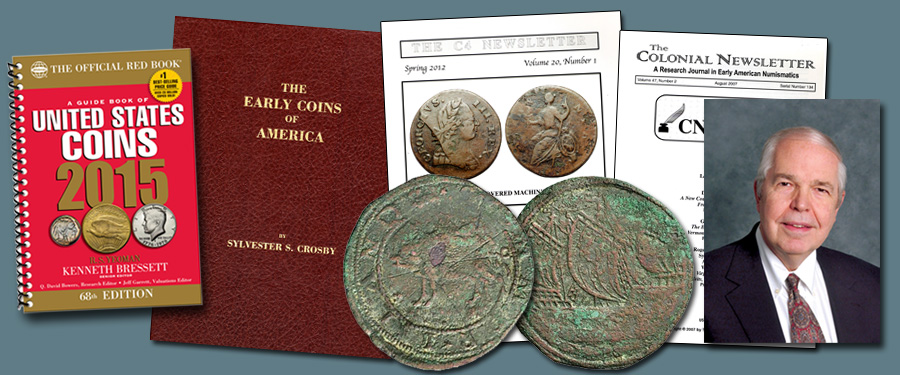
This week I continue my series traveling through the 68th edition (2015) of A Guide Book of United States Coins. This familiar red-covered reference book has been published yearly since 1946 (the first issue having a 1947 cover date to preserve shelf life). At the forthcoming Whitman Coins & Collectibles Expo in Baltimore in the last week of March the 69th edition will be launched, after which it will be available from bookstores, coin dealers and hobby shops nationwide, as well as on the Whitman Publishing, LLC website.
I continue my narrative beginning with page 12 of the 68th edition. We are in the colonial era of American history, in which various colonies, mainly settled by British immigrants, had sprung up on the Eastern Seaboard of what is now the United States. In time there were 13 colonies, the last being Georgia.
In the colonial era money was scarce. Foreign coins, especially those from the Spanish-American countries to the south, were the mainstay of commerce. The one real or “bit” worth 12-1/2 cents was the unit of value with two reales or two bits being worth a quarter (a term still used today for 25 cent coins) and eight reales being worth a Spanish dollar. Gold coins of the Spanish-American countries circulated widely as well and were valued in escudos, one escudo being worth $2 and eight escudos (or doubloon) being worth $16. Coins from Europe circulated as well, including from Great Britain, France, the German states, and Italy. The barter system was widely in effect in colonial America and goods such as bushels of corn, musket balls, tobacco and even cows could be exchanged for other goods and services.
Now I jump from page 12 of the Guide Book to page 36, landing on “British New World Issues.” These are generally considered to be the first coins made for use in the colonies, but the description is more traditional than factual. These pieces were made for the Sommer Islands, known as Bermuda today, named after Sir George Sommers, who was shipwrecked there while on the way to the Virginia plantation at Jamestown (which had been founded in 1607). Escaping from the wreck were a number of hogs, which made themselves comfortably at home in the islands, soon overrunning the area, much as rabbits did in Australia in a later era. The wild hog became a symbol, and the coins minted in England circa 1616 bore their image on one side and a sailing ship on the other. Bermuda was not within the area of the American colonies, but from an early time such pieces were described as having an American connection.
Today several hundred examples exist of the Sommer Islands coins, years ago called Hogge money, in the denominations of twopence, threepence, sixpence and shilling. Nearly all of these show signs of wear and many are irregular or oxidized from long-term burial in the earth. Some interesting discoveries have been made on the islands in recent years. When issued these were lightly silvered brass, but on most the silver has disappeared. The Guide Book prices colonials from About Good-3 up to EF-40, but in practice the vast majority of those in numismatic hands are About Good, Good and Very Good.
I mention here that a specific mindset is needed to collect such early coins. Newcomers to the hobby, used to U.S. Mint commemoratives and other issues that can be found in MS-70 grade (perfection), or MS-68 or MS-69, may have a hard time realizing that traditional numismatics is founded upon coins that for the most part have been widely circulated in commerce. There is no such thing as a Mint State-60 Bermuda coin, never mind Mint State-70. Worn pieces have a special charm to them, but it takes some getting used to as so much market emphasis is on ultra-high grades.
Next week I will discuss Massachusetts silver coins, the first pieces actually struck within the boundaries of what is now the United States. The term colonial coins refers to pieces from the 1600s up to the Revolutionary War (ended in 1781, made official by the peace treaty of 1783), and the confederation and adoption of the Constitution in the same decade. In the 1780s certain states issued coins, which I shall discuss later. Coins and tokens relating to President George Washington and bearing dates from 1783 to 1795 are collected under the umbrella of early American coins.
Various issues from the 1600s through 1795 appeal to many different collectors — perhaps as many as 1,000 or 2,000. If the number were much larger than this there would not be enough coins to go around. A “common” colonial coin may be one of which two dozen are known. Such would be an extreme rarity if part of the federal series.
There is one prime meeting point for enthusiasts, the Colonial Coin Collectors Club, nicknamed C4. Check out the website and become a member. The C4 Newsletter, edited by Syd Martin, contains research information, new discoveries, commentary and more, and is well worth subscribing to.
The American Numismatic Society, based in New York City, publishes The Colonial Newsletter, which has traditions dating back more than 50 years. Back issues are available in electronic form. Cumulatively, the CNL has a vast amount of information.
Beyond this, there are many specialized reference books on various colonial and early American coins, information concerning which can be found on the Colonial Coin Collectors Club website and elsewhere on the Internet.
The standard reference, essential for any numismatic library, is Early Coins of America, by Sylvester S. Crosby, published in 1875 and reprinted several times since then. Amazingly, this reference book is still a standard source!





